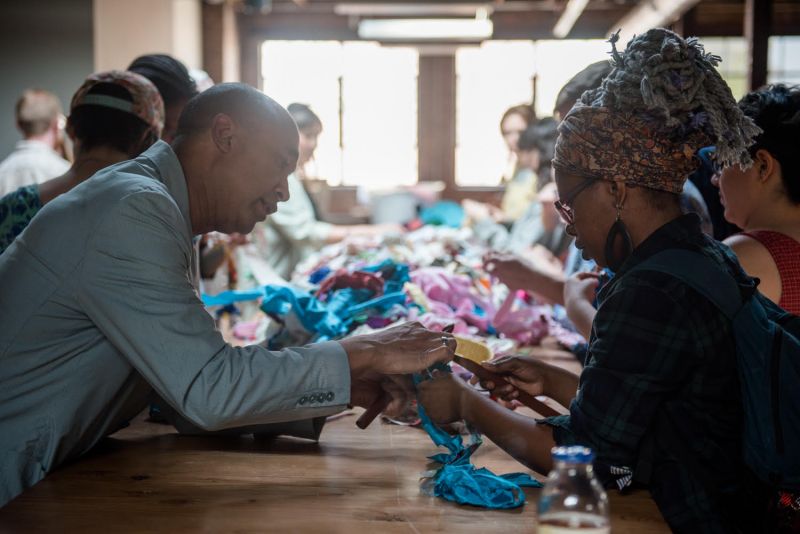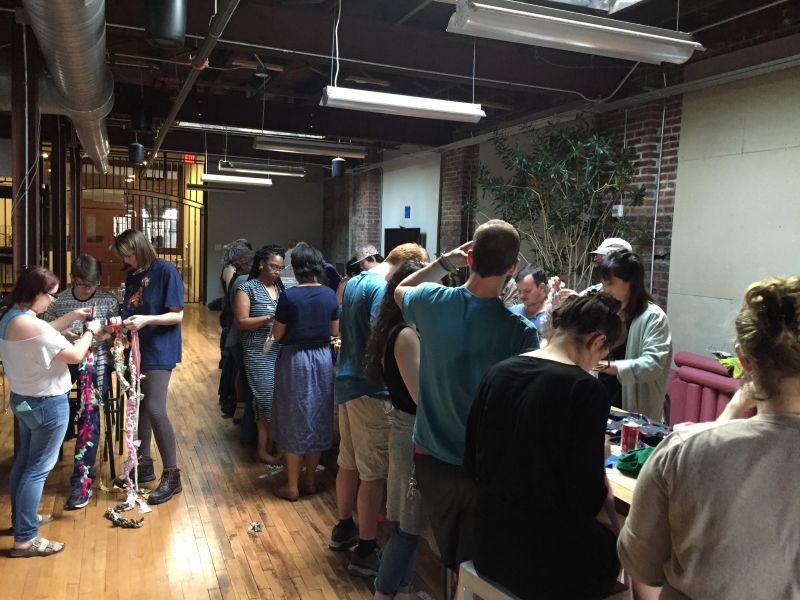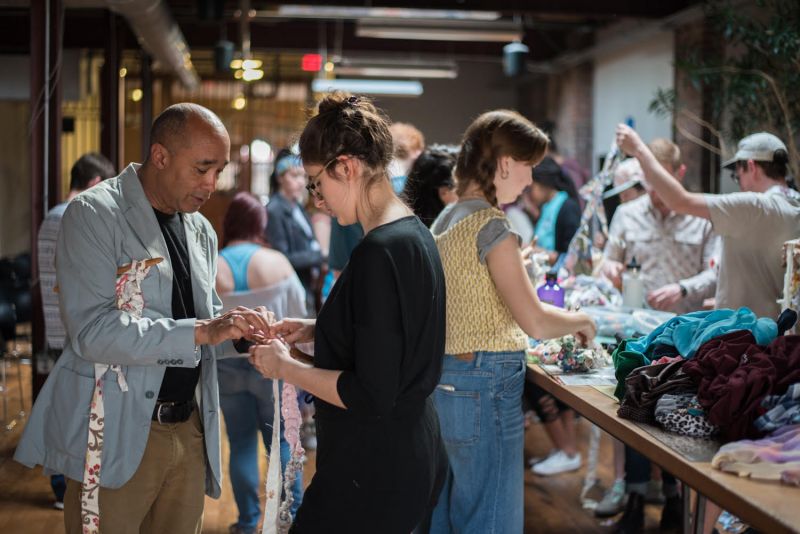Crochet Jam: Radical Social Justice Through Folk Art Traditions

Crochet Jam 2017, Virginia Commonwealth University (VCU), photograph courtesy VCUArts
Excerpts from an unpublished manuscript...
Creativity makes us kin . . . the goal is to quickly and easily engage participants in a relaxed and creative state by transforming cloth strips into soft sculpture, using folk-art tradition of rag-rug making. Crochet Jam . . . is a bridge that unites people and cultures.
I grew up on a small farm. My father harvested a bounty of vegetables–cabbage, green peas, onions, white and sweet potatoes, green beans, corn, beets, squash, cucumbers, watermelons, cantaloupes, green and red peppers, lettuce. We raised pigs, chickens; and even earthworms to lure fish from the nearby pond. The backyard also had many fruit trees—pears, peach, mighty tart apples, and a cranberry tree with really tangy berries.
But we did not grow carrots. Carrots were a mystery to me. I told my father that I could not wrap my brain around how carrots could push the dirt away to grow down. How could any vegetable be strong enough to do that?
My father told me to get in the car. Then he yelled across the yard to tell my mother that he and I were going to the Farmers’ Feed & Seed Store to get carrots seeds.
“Carrot seeds?” my mother yelled back. “Who eats carrots?”
“This boy wants to grow some carrots,” my father told her.
At the store, we bought enough seeds to plant a row of carrots. My father told me that he would show me how to plant the seeds but it would be my job to cultivate and water the plants. For weeks, I cared for my carrots with special attention. I was told not to overlook the other vegetable on the farms. I would loosen the soil around the plants, what my father called hoeing the row, two or three times a weeks. When the soil was loose around the roots of the carrots, they were able to push the soil away, and grow into the ground.
My mother and grandmother expressed their worldview and emotions through textile and fabric. My mother, a textile worker at Hanes Knit, which was at one time located in Winston-Salem, North Carolina, was a piece-mill worker. She spent long days sewing sleeves onto t-shirts. She taught me how to operate a sewing machine. At a young age, she taught me how to thread the machine, how to sew a button, how to do single-stitch sewing and other techniques with the machine.
My grandmother was a quilt maker. She made beautiful quilts for my brothers, sisters, and me. We were guaranteed a quilt for our bed in college.
My grandmother lived next door to us, and on one of my visits she was seating on the bed, quilting. As I came into the bedroom, she turned toward me and said, “Boy, come over here and help me with this quilt.”
The last thing I wanted to do was to participate in a craft project that would put in question my masculinity. I was already at an age where I was becoming aware of my same-sex attraction. Quilting and sewing had made me suspect, afraid, and withdrawn. I was contemplating all of this as I was walking toward her. Expressing my displeasure with my grandmother’s request would have been a serious mistake.
She calmly looked up at me and said, “Pick any color or pattern you like, and I will show you how to add it to my quilt.” Her quilt already had an intricate pattern, which meant months of work. That didn’t seem to matter to her. She was allowing me to break the pattern of the quilt. I was that important to her.
This was in an era when the oppression and cruelty of de-facto Jim Crow segregation was the law of the land. I remember watching movies in my hometown in the balcony of the theater because it was illegal for Black people to enter the lobby. Homophobia was just as rampant. It was also a time when Black men and women were fighting for equal rights across the country. Black people were redefining themselves as strong individuals, worthy of respect and equality.
My grandmother knew that I was struggling with something. She intuited that I needed to feel embraced, accepted, and heard. We did not talk much. She taught me how to quilt pretty much in silence. She never told my parents. It was just the two of us. It was a most loving act.
These and other experiences from my childhood were the foundation of what formed the realm of my understanding of creativity. From my father, I learned the importance of observation, patience, and active problem-solving. He took my curious mind and wacky ideas seriously. He did not make fun of me nor dismiss my childlike interests. He instilled in me the sense that I was important, and worthy of attention from people in authority.
From my mother and grandmother who were steeped in folk-art traditions, I learned to appreciate skills and techniques that I could much later subvert and incorporate into radical self-expression. As a Black, queer male, I was as marginalized as the techniques in quilt making and sewing that the women in my life were teaching me. I also learned that craft culture can instill calmness, healing, and acceptance, especially when one can break the rules and not be judged by the finished product
Crochet Jam has its roots directly in the kindness and acceptance that my grandmother extended to me. I have spent much of my time, much of my life pleasing others, pleasing authority, first pleasing my parents out to fear for my life and later pleasing my peers, teachers, professors, ministers, employers, police officers, gallery directors, curators, and so on. I finally realized that if I continued to focus on pleasing others, I would never know who I am.
For the majority of my art career, I relinquished my agency over and over again when I approached figures of power in the white art world-- curators, gallery directors, museum directors–and presented my work, asking for their approval. Is my work good? Is it worthy of your gallery? Am I good enough?
At some point this system no longer worked for me. So I decided to stop presenting my work to anyone. I surmised that the art world was not designed to help and support Black artists. Galleries and museums are there to confirm and maintain the status quo.
I needed time to reflect, to sit back and re-evaluate. Time to stop doing the same things while expecting different results. After a few months, I realized that everyone in my family used fabric and textiles to express their worldview. My mother and especially my grandmother made quilts, using contrasting colors and improvisation. Their creations were like jazz, reflecting how Black people in the US driven by necessity, used color to lift their spirits in a hostile environment and employed improvisation to solve problems in a world where opportunities were limited, and kept out of reach due to the evils of racism.
The women in my family intuitively understood the importance of making-do with what you have. The quilts were functional, inspirational, and radical. Trust your experiences and; metaphorically speaking, build your house. You can’t use the tools, the way of thinking, or the system of the oppressor to communicate the Black experience. No one in my family painted on canvas to express their worldview.
I decided to move away from using tradition materials in my art. Working with fabric and textiles was truly authentic to my experience. So, I decided to translate my quilting experiences with my grandmother, in which she allowed me to break the patterns in a safe environment–into STITCH–a community event in my home where I invited friends to sew rag rugs. Then in 2012, when I received an artist-in-residence at the de Young museum in San Francisco through the public-programming department, the same community-art project turned into Crochet Jam–a public, art-making event that's embracing and inclusive, with no attempt made to dictate the creative process nor judge the finished project. The experience is meditative, liberating, and empowering.

Crochet Jam 2017, Virginia Commonwealth University (VCU), photograph courtesy VCUArts
We are told what do all of our lives. There is always someone with more power and control over us. It starts with our parents—our first tyrants. We listen and obey them out of fear for our lives. It is intuitive to know that we must please them or they may decide to mistreat us or worse, abandon us. We learn to conform to survive. It doesn’t stop there. We learn to obey and conform, denying ourselves for the pleasure of others, including teachers, ministers, police, governors, presidents, and so on. Always pleasing others, we lose ourselves and eventually we never learn how to engage the world nor ourselves bravely, independently, subversively. To be who we need to become, one must subvert. No one can be who they need to become if they are constantly denying oneself to please others.
The penalties are high. If we do not conform then we run the risk of falling out of favor, eventually becoming persona non grata, shunned. We are not appreciated or loved in the same way that those who conform are, no matter what. These individuals are very dangerous, for they will do whatever it takes to stay in favor, psychopathic opportunists.
Crochet Jam is autobiographical. It is all of my pain and frustrations translated into an event centered on liberation, social interaction, and creativity. I feel that I have been told what to do all my life. Through a process of indoctrination often carried out by religion, the public and private school systems, television, movies, films, print media, commercials and more, we inculcate the morality, ethics, and worldview of the dominant culture. None of it is designed to empower and liberate the individual. It is designed to manipulate how we think and manifest supreme conformity. Independent and critical thinking is criminalized, outlawed. Even if somehow one manages to acquire these skills, that individual is marginalized.
Through my community-art event, Crochet Jam, I do not dictate the creativity process. Participants maintain their agency. There is no need to please me. I have no authority over anyone. I am just the guy facilitating the event. I am just a man on the street, standing behind a folding table that’s covered with stripes of torn and cut fabric. I teach single-stitch crochet using a handmade wooden hook and torn strips of fabric. The learning curve is about five minutes. Once you learn the technique, I have no more to teach. The fabric then becomes the teacher.
The difficult part is liberating the fabric enough to allow it to become whatever it wants to be. There is no focus on a finished product. Therefore, the fabric can transform as it pleases, without any regard to the outcome. Whatever it becomes, one accepts it as it is, without judgment.
Participants arrive at Crochet Jam events believing that I am going to teach them how to make a rag rug, scarf, or a potholder. I take them on a completely different journey—a journey designed to challenge how they think about themselves and the role and purpose of art as a means toward liberation, freedom, and creativity. I take them on a journey through my childhood, in which, I do for them what my grandmother, mother, and father did for me decades ago. I allow them to have an experience to safely make mistakes, observe, engage, explore in a way that is new for many people.
Through my Crochet Jam events, it has become very obvious to me the humans carry a great deal of pain, unhappiness, fear, violence, heartbreak, and anger. Most people are unaware of the source of their discontent. I remember a Crochet Jam in Asbury Park, New Jersey. As the event started, I noticed that there was a man standing across the street from the park. He was staring at the people gathered around tables and chairs with two or three large piles of very colorful fabric in the center. He walked away. Later, he returned, standing across the street again, watching. Finally, he walked over and asked what is going on.
“Welcome to Crochet Jam!” I said. “It’s a free public event, in which we use the folk-art tradition of crocheting strips of fabric to foster social interaction, liberation, and creativity.” I remember hoping he would join us. He did. He participated for a while, and on his own started helping others, showing them how to single-stitch crochet. It pleased me to see participants feeling empowered and secure in themselves, teaching others.
Before he left, the man said good-bye to his new Crochet Jam friends. Then he walked over to me. “My father died a few days ago,” he said, “And I had nowhere to go. Thank you for being here.”
He walked away, leaving me emotional and speechless.
For me, Crochet Jam is an act of love. My father, mother, and grandmother created a safe environment in which I could break the rules and not be judged, enlarging my sense of self, worldview, and confidence in positive ways. I needed what my parents did for me. I could not be who I am without it. I needed it then, as I need it now and so does everyone. Crochet Jam is my family legacy, expanding the positive influences my family had on me in this regard to others, to strangers, to as many people as possible.
 Crochet Jam 2017, Virginia Commonwealth University (VCU), photograph courtesy VCUArts
Crochet Jam 2017, Virginia Commonwealth University (VCU), photograph courtesy VCUArts
Syndicated with permission from the author. Ramekon O'Arwisters is an African-American artist, best known for his fabric and ceramic sculpture and his community-art practice, Crochet Jam. He creates art using the folk-art tradition of rag-rug weaving. Ramekon's work has been exhibited in New York, North Carolina, Florida, California, New Mexico, Canada, and Japan.
SHARE YOUR REFLECTION
3 Past Reflections


On Oct 14, 2020 Kristin Pedemonti wrote:
Thank you! Thank you for sharing your multi-layered life experiences and showing us how you were able to break through the constraints of indoctrination, subjugation, racism & heteronormativity to gift others through liberation of an art form that brings so much joy!
Inspired!
PS. The work I do with Narrative Therapy is all about breaking through the stories society and patriarcy place upon us & you've beautifully illustrated the glory of pushing through & pursuing your preferred Narrative!
Hugs from my heart to yours!
Kristin

On Oct 14, 2020 liberatingenglish wrote:
What an amazing, heart-warming and insightful article... Much of what as said, I was transposing into my experiences as a teacher of English and the debate around how White, Perceived as Native speakers of English, insist on judging people of colour as Non-Native Speakers of English who are then, suspect in term of their teaching skills.
1 reply: Kristin | Post Your Reply

On Oct 15, 2020 Eduardo Contreras wrote:
You are a true inspiration Mr. Ramekon! I just want to thank you from the bottom of my heart. Your kindness gives me strength sir.
Post Your Reply